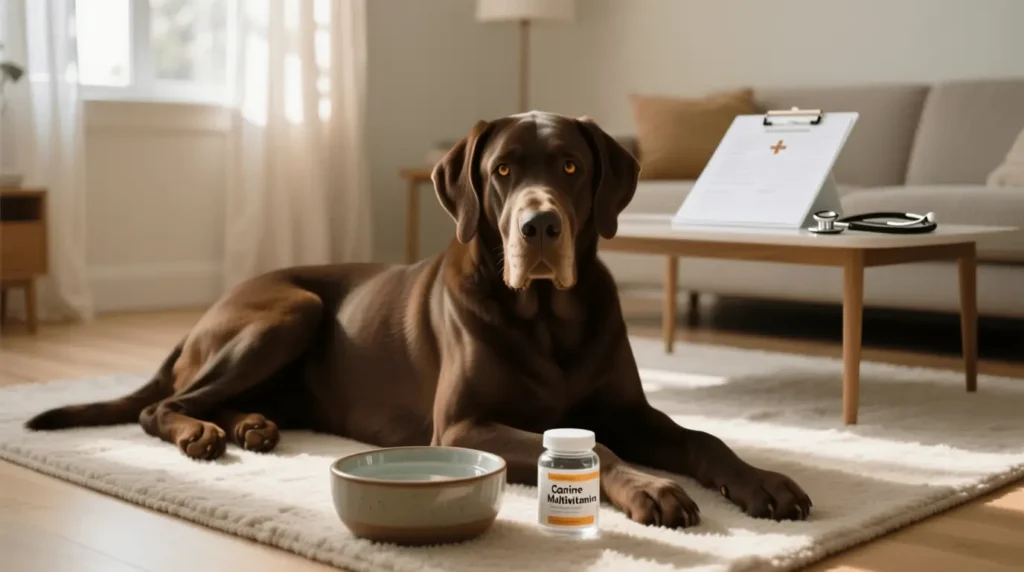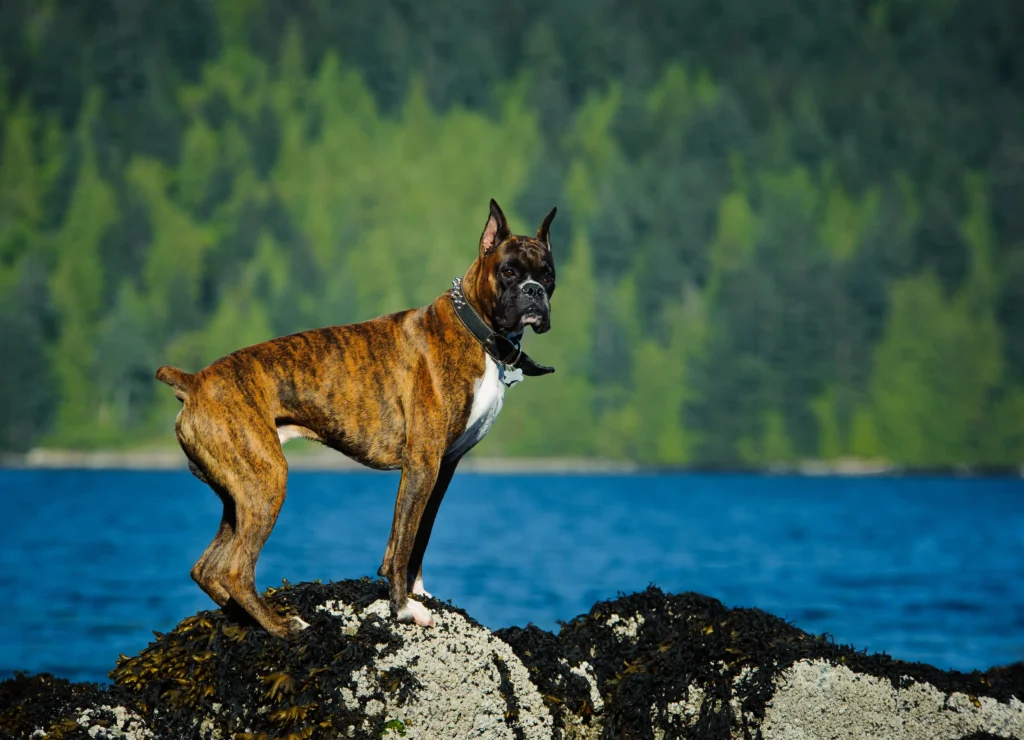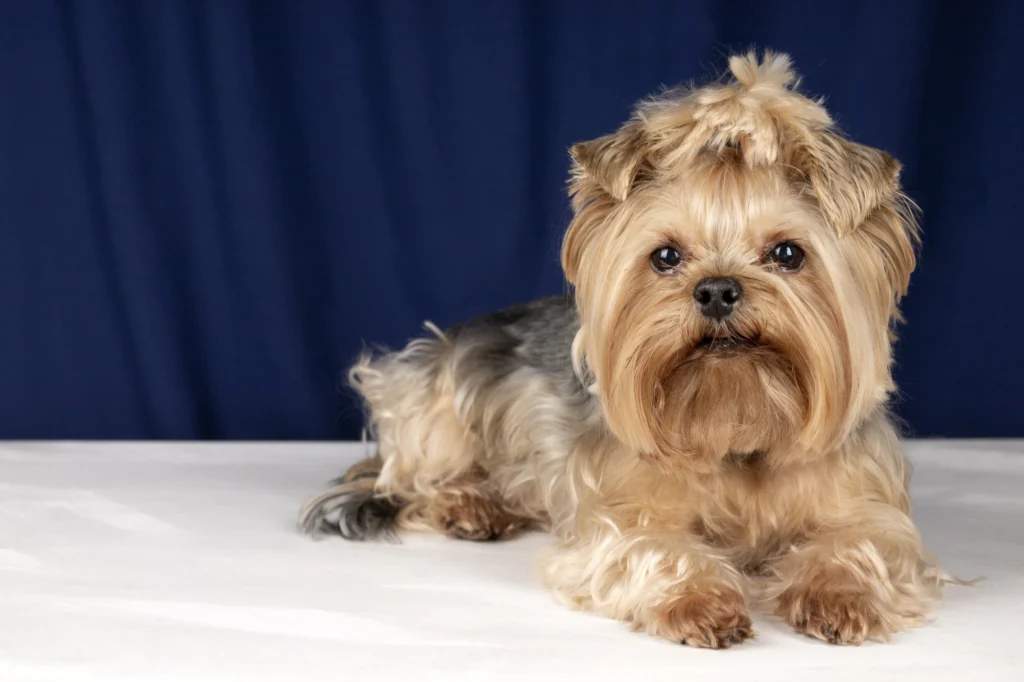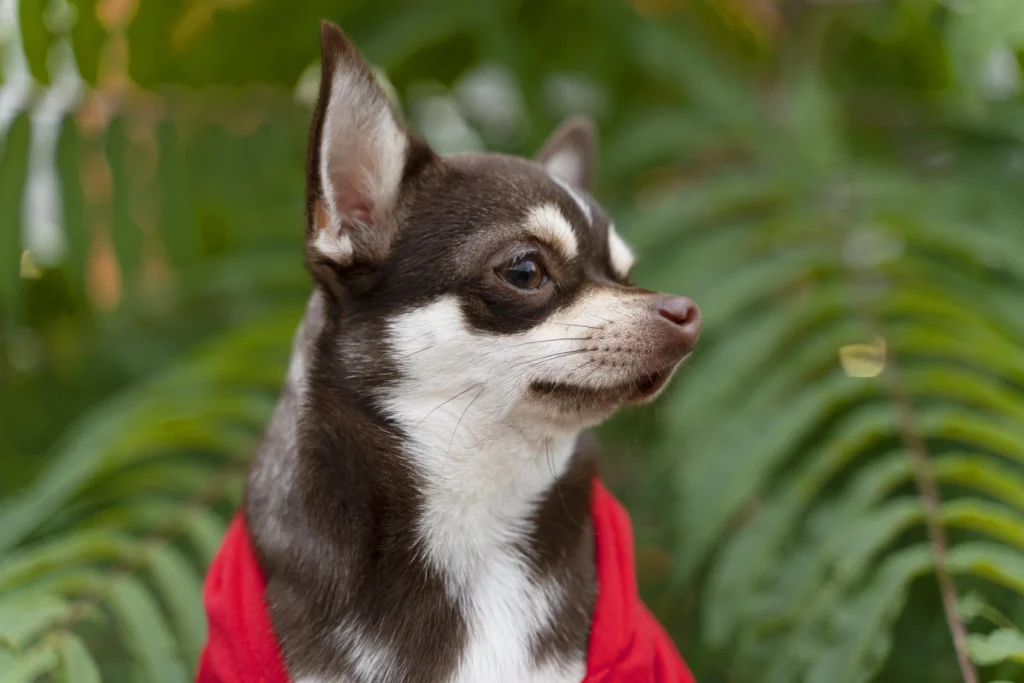Something nearly poetic about the view of a Great Dane dashing over a sun-lit lawn is the impression of splendor counterbalanced with elegance. Rising to about five feet on its hind legs and high-headed, with apparently possessing some kind of silent wisdom in its eyes, the Great Dane is not obeyed by brutality, but by an instinctive nobility. Each move of this breed is a contrast study: the bulky frame is running with the lightness of the dancer, the deep chest is rising and falling with the soothing sound of a creature that has nothing to demonstrate. Indeed, it is no wonder that cynologists and fanciers have long referred to the Great Dane as the “Apollo of Dogs,” borrowing from Greek mythology’s god of light, poetry, and harmony, a fitting metaphor for a dog whose beauty lies in both power and proportion.
This guide is aimed at delving into the Great Dane in all its aspects, its European background, its essence, its temper, which borders with the sublime, and the facts of its care and health that each potential owner must know. It takes a lifetime to learn this breed and love its sublime combination of power and fragility, the handiwork of humans and the silent pride of the dog nature.
Origins and History
The Ancient Roots: Bullenbeissers, Boarhounds, and Molossians
The genealogy of the Great Dane is complex and intertwined with many lost types of large dogs. One ancestral form is the Bullenbeisser (literally “bull biter” or “bull-catcher”) of medieval Germany, a powerful dog used to hunt boar and other large game. Over centuries, these dogs were paired with tall sighthound types (e.g., those used for chasing deer), and perhaps crossed with mastiff types, to blend speed with strength.
Some older theories even trace visual antecedents to ancient civilizations, citing Assyrian and Mesopotamian art that depicts giant dogs with short coats and muscular frames. Whether such animals were direct ancestors is debated, but they do hint at a longstanding human desire for imposing, noble dogs.
The German Development and the “English Dogge”
By the 16th and 17th centuries, German nobility began importing and breeding large dogs sometimes referred to as Englische Dogge (English mastiff types) for hunting large animals like boar. As firearms became more widespread, the utility of dogs for hunting large game declined, and the role of these dogs shifted toward estate guardianship, companion status, and show dogs.
In 1878, a committee in Berlin formally changed the breed’s German name from Englische Dogge to Deutsche Dogge (German Dogge), setting a framework for what would become the modern Great Dane. In the late 19th century, international interest grew; a breed club (Irish terrier club) formed in the U.S. in 1889.
The Name “Great Dane” and the “Apollo of Dogs”
Interestingly, despite the name, Great Danes are not of Danish origin. The term Grand Danois was coined in French by naturalist Comte de Buffon in the 18th century, and that phrase (or its English rendering, “Great Dane”) stuck in many countries. In Germany, the breed is still known as Deutsche Dogge.
The appellation “Apollo of Dogs” reflects the impression many breeders and enthusiasts invoke: a creature of symmetry, majesty, calm dignity. The official breed standard even uses that phrase: “It is always a unit, the Apollo of dogs.”
Physical Characteristics & Breed Standard
Overall Conformation
Great Danes are, by definition, a giant breed. According to breed standards, the dog should present as square in proportion (its height from the withers equals its body length from the sternum to the base of the tail). Males are typically required to measure at least 30 to 32 inches (76 to 81 cm) at the shoulder; females at least 28 to 30 inches (71 to 76 cm “Danes under minimum height are disqualified” is a clause in the standard.
Though they are giant, they should carry themselves not with clumsiness, but with balance, elegance, and smooth motion. The limbs should be straight, strong, and muscled; feet well-padded; tail long but tapering.
Coat, Colors, and Head
The coat is short, smooth, and tight to the body, easy to maintain but still requiring regular brushing to remove shed hair. Recognized colors (varying by kennel club) include black, blue, fawn, brindle, harlequin (white with black patches), mantle, and sometimes merle.
The head is rectangular in profile, with a flat skull, moderately long muzzle, and well-defined lips. Eyes are dark and expressive, conveying intelligence. Ears may be left natural (hanging) or cropped (though cropping is controversial and disallowed in many jurisdictions).
Notable Records & Giants
Throughout modern times, Great Danes have often claimed records for height. For example, Giant George was once recognized as the tallest living dog, with impressive measurements and weight. Later, Zeus (b. 2019) held the title for tallest dog, standing over 1.046 m (about 41 inches) at the shoulder before he died in 2023.
Temperament, Behaviour & Personality
The Gentle Giant Nature
One of the most appealing facets of the Great Dane is its temperament. Though bred for strength and, historically, hunting, the modern Dane is often described as calm, dignified, affectionate, and loyal: a gentle giant.
They are typically friendly toward known people and children (with supervision), and can be reserved but not aggressive to strangers when socialized properly.
Because of their size, temperament is crucial. A poorly socialized or poorly trained Dane can inadvertently cause harm (e.g., knock over a child). The breed standard states they “must be spirited, courageous, always friendly and dependable, and never timid or aggressive.”
Intelligence, Trainability & Challenges
Great Danes tend to be intelligent dogs, able to understand commands and form strong bonds, but their sheer size often makes mistakes costlier. They respond best to positive reinforcement and patient, consistent training. Punitive methods often produce fear or resistance.
Early socialization (exposure to different people, animals, and environments) is essential within the first few months. Without it, they may become anxious or overly cautious in new situations.
Because growth is prolonged in giant breeds, certain exercises (e.g., jumping, heavy running) should be postponed until skeletal maturity (often 18 months or more) to protect joints.
Social Dynamics & Suitability in Families
Great Danes often do well in homes with children and other pets, provided training, supervision, and proper introductions are handled carefully. Their calm nature lends itself to companionship, not hyperactivity. Still, the space they occupy and the care they demand mean they are not ideal for everyone.
Health, Lifespan, and Common Disorders
Typical Lifespan and Health Overview
One of the inevitable challenges of giant breeds is a shorter lifespan. Great Danes typically live 7 to 10 years, though many fall toward the lower end of that range. Because of their size, Danes are predisposed to several serious health conditions. Some of the more common and critical ones include:
Gastric Dilatation–Volvulus (GDV, “bloat”)
This is perhaps the single most feared condition in Great Danes. The stomach becomes twisted and distended, cutting off blood flow and quickly becoming life-threatening. Many owners opt for prophylactic gastropexy (surgically tacking the stomach to reduce the risk of twisting) while the dog is still young.
Feeding strategies (multiple smaller meals, slow-feed bowls, avoiding vigorous exercise near mealtime) can also reduce risk.
Hip Dysplasia and Joint Issues
As with many large breeds, hip dysplasia (a malformed or unstable hip joint) is a risk. Over time, it may lead to arthritis, pain, and mobility issues.
Supporting joint health with an appropriate diet, weight management, and safe exercise is key. Some Danes are screened by breeders for hip health before breeding.

Wobbler Syndrome (Caudal Cervical Spondylomyelopathy)
Great Danes have long necks and heavy heads, making them susceptible to spinal problems. Wobbler syndrome involves vertebral instability in the neck, causing a staggering gait, neck pain, and neurologic deficits.
Proper nutrition, avoiding extreme physical stress during growth, and close veterinary monitoring are important preventive measures.
Cardiovascular Disease
Dilated cardiomyopathy (DCM), where the heart enlarges and weakens, is more common in giant breeds, including Danes. Symptoms may include coughing, difficulty breathing, weakness, and sudden collapse.
Other Conditions
- Happy Tail Syndrome — repeated injury to the tail’s tip due to its length and active wagging.
- Degenerative Myelopathy — progressive spinal cord disease affecting rear limb function.
- Gastrointestinal, thyroid, and ocular disorders also occur with lesser frequency.
Preventive Care & Veterinary Strategy
Because of these risks, Great Danes require vigilant preventive care:
- Routine veterinary checkups, including orthopedic, cardiac, and neurologic function
- Radiographic (X-ray) screening of hips, elbows, and spine when young
- Controlled nutrition (especially in puppyhood) with large-breed puppy formulas
- Weight management to avoid stressing joints
- Careful scheduling of exercise and rest
- Consideration of prophylactic surgeries like gastropexy
- Good access to pet health insurance or a financial plan to handle emergencies
Nutrition, Exercise & Lifestyle Needs
Feeding & Growth Considerations
During puppyhood, Great Danes grow slowly but steadily, and the diet must support bone growth without overloading joints. High calcium, phosphorus, or “all life stages” diets can push too much growth too fast. Many breeders and veterinarians recommend large-breed puppy formulas until 18 months or more.
Once an adult, feeding multiple meals (2 or more per day) instead of one large meal helps reduce bloat risk. Some owners use slow feeders or raised bowls (though the latter is debated).
Quality protein, joint supplements (glucosamine, chondroitin) in moderation, and avoiding unnecessary fillers are common principles.
Exercise and Activity
Though not “hyperactive,” Danes still need daily exercise: long walks, moderate play, and mental stimulation. However, vigorous exercise or jumping when young is discouraged.
When fully grown, they may enjoy more freedom, but always within reason (e.g., avoid high-impact sports). Their stature means that spatial awareness is important: they must learn not to knock things over or push through narrow spaces.
Living with a Giant
A Great Dane in the home means thinking big:
- Adequate floor space and room to stretch
- Strong, secure doors and fencing (they may accidentally push through weak barriers)
- Durable bedding, elevated when possible
- Grooming tools suited to a large frame
- Extra food, medicine, and supplies cost
- Transportation accommodations (vehicles with enough space)
Choosing a Great Dane: Breeders, Adoption, and Assessing Quality
Selecting a Reputable Breeder
Because of the health risks in the breed, responsible breeding is paramount. A good breeder:
- Screens for hip dysplasia, cardiac disease, and other known issues
- Has health certificates and lineage records
- Allows you to meet the puppy’s parents
- Provides a written health guarantee
- Encourages the return of the dog to them if you cannot care for it later
- Emphasizes temperament, socialization, and long-term care
Resist anyone offering puppies too cheaply, without screening, or unwilling to share health history.
Adoption & Rescue Options
Many Great Danes are available via breed rescue organizations, local shelters, or Great Dane clubs. Adoption can be a wonderful path often mature dogs with known temperament and medical history. Do your homework on the dog’s background and preparation for its large size.
Puppy vs Adult: Pros and Cons
- Puppy: You shape temperament, socialization, but are more vulnerable to mistakes and growth issues.
- Adult: more predictable temperament, possibly already trained, but fewer years left, and potentially more existing health burdens.
Evaluating a Puppy or Dog
Look for:
- Balanced, confident temperament (not timid, not overly bold)
- Good movement (straight legs, smooth gait)
- Healthy eyes, ears, skin
- No signs of joint or neurologic issues
- Clean, well-maintained environment from the breeder
- Access to health and lineage documentation
Real-Life Stories & Anecdotes
Juliana: Heroic Dane of the Blitz
One Great Dane named Juliana earned fame during World War II in Britain. Reportedly, during an incendiary bomb attack, Juliana urinated on an incendiary bomb that had fallen through her home’s roof, extinguishing it and saving lives. For this, she was awarded a Blue Cross medal. Later, she also alerted her owners to a fire.
These stories stress the point that despite their stature, Danes are capable of acting with presence, loyalty and even heroism.
Giants in Pop Culture
- Giant George: once held the Guinness title for the tallest living dog.
- Zeus: another record-holder.
- Fictional Great Danes include Scooby-Doo, Marmaduke, and others; these characters have influenced popular perception (sometimes overemphasizing cartoonish traits).
Difficulties, Mentalities and What to Beware of
- Underestimation of size: Most individuals are not ready to have a large amount of space and resources that a Dane requires.
- Short life: You have to be emotionally ready to embrace that your Dane is not going to live as long as the smaller breeds..
- Cost of health: veterinary treatment may turn out to be a costly affair due to acute or chronic condition.
- Strength: A well behaved Dane will unintentionally bump, shove or overrun smaller creatures.
- Overbreeding and reckless breeding: never fall prey to puppy mills, unvetted puppies and hype.
- Misconceptions: “All great Danes are aggressive” is false; the breed standard insists on friendly and dependable temperaments.
How big are Great Danes?
How big are Great Danes?
According to the American Kennel Club (AKC) breed standard, male Great Danes typically stand 30–32 inches tall at the shoulder and females 28–30 inches. Some males exceed 34 inches, making them among the tallest dog breeds globally. Their weight ranges from 100 to 120 pounds, with some reaching 180 pounds depending on genetics and nutrition.
How tall can a Great Dane get standing up?
When standing on their hind legs, adult male Great Danes can reach 6.5 to 7 feet (2.0–2.1 m) in height. This remarkable stature has earned them the nickname “Apollo of Dogs.”
How much does a Great Dane weigh?
On average, males weigh 100–120 lbs (45–54 kg), and females 90–110 lbs (41–50 kg). A healthy adult’s weight depends on skeletal frame and muscle tone. Maintaining a Body Condition Score (BCS) of 4–5/9 is recommended by the VCA Animal Hospitals to avoid joint and gastric issues.
How tall can a Great Dane get standing up?
When standing on their hind legs, adult male Great Danes can reach 6.5 to 7 feet (2.0–2.1 m) in height. This remarkable stature has earned them the nickname “Apollo of Dogs.”
(Source: Guinness World Records & AKC breed data, 2024)
What were Great Danes bred for?
On average, males weigh 100–120 lbs (45–54 kg), and females 90–110 lbs (41–50 kg). A healthy adult’s weight depends on skeletal frame and muscle tone. Maintaining a Body Condition Score (BCS) of 4–5/9 is recommended by the VCA Animal Hospitals to avoid joint and gastric issues.
How much does a Great Dane cost?
A responsibly bred Great Dane puppy typically costs $1,200–$3,000 USD, depending on lineage, registration, and health certifications (Orthopedic Foundation for Animals, 2024). Adopting through rescue organizations can reduce costs and support ethical breeding practices.
Are Great Danes aggressive or dangerous?
No, aggression is not typical of the breed. According to Cornell College of Veterinary Medicine’s Behavioral Health Unit (2023), well-socialized Great Danes display low reactivity and stable temperaments. Aggression is usually linked to fear, pain, or neglect rather than breed disposition.
Are Great Danes hypoallergenic?
No. Great Danes are not hypoallergenic; they have short coats that shed moderately and produce dander. Regular brushing and home air filtration can help allergy-sensitive owners (American College of Allergy, Asthma & Immunology, 2024).
How much to feed a Great Dane?
Adult Great Danes require 2,500–3,000 kcal/day, divided into 2–3 meals. Feed large-breed adult formulas rich in protein (22–26%) and moderate fat (12–16%), and avoid feeding immediately before or after exercise to prevent bloat (WSAVA Nutritional Guidelines, 2023).
Conclusion
The Great Dane is more than just a tall dog; it symbolizes nobility, loyalty, and gentle strength. Their great height, dominating nature and love make them great guardians and adoring family members. Although their care levels need to be monitored in terms of diet, exercise and health check, the benefits of ownership of a Great Dane are unparalleled. They may be beautiful and loyal and attracted you by their grace or they may have a soft kind of character that you simply are captivated by, but anyone way you look at it, the Great Dane really is the Apollo of Dogs.
Through training, socialization and care, Great Danes are capable of thriving in the family settings and provide a mix of majesty and comfort that no other type of dog can offer. Having a Great Dane is a responsibility and a companion but is a reward that gives the owners a life long, faithful companion.


